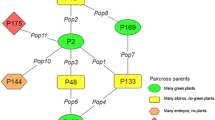Abstract
Inheritance of microspore embryogenic ability in oilseed rape (Brassica napus L.) and Chinese cabbage (Brassica campestris L. ssp. pekinensis) was examined by 4 × 4 diallel crosses using cultivars showing a different response. In both species, embryo yields of most F1 hybrids were similar to, or over, the high responsive parent and some F1s showed intermediate embryo yields between their parents. Diallel analysis showed that both additive and dominant effects were significant at the 1% level for the genetic control of microspore embryogenic ability in both species. Dominant genes had positive effects on microspore embryogenesis. In oilseed rape, the additive effects were important, while in Chinese cabbage the dominant effects were largely contributed. The broad- and narrow-sense heritabilities were 0.972 and 0.811 in oilseed rape, and 0.959 and 0.659 in Chinese cabbage, respectively. From the results of the segregation of embryo yields in the F2 population of ’Lisandra’×’Kamikita’, it is considered that the microspore embryogenic ability is controlled by two loci with additive effects in oilseed rape.
Similar content being viewed by others
Author information
Authors and Affiliations
Additional information
Received: 6 September 2000 / Accepted: 24 November 2000
Rights and permissions
About this article
Cite this article
Zhang, F., Takahata, Y. Inheritance of microspore embryogenic ability in Brassica crops. Theor Appl Genet 103, 254–258 (2001). https://doi.org/10.1007/s001220100602
Issue Date:
DOI: https://doi.org/10.1007/s001220100602




